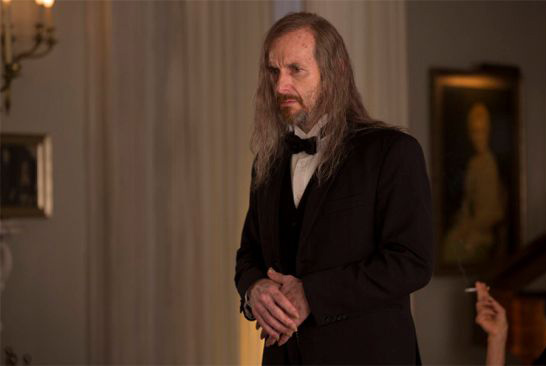
The Bechdel Test, coined by cartoonist Alison Bechdel (Fun Home, Dykes to Watch Out For), assesses whether a work contains two female characters who are able to talk to each other about something other than a man. Start watching mainstream media through Bechdel’s lens and you’d be surprised how often TV, movies, and even books and comics, fail this basic standard.
If there were an inverted Bechdel test, one that measured men’s conversations that didn’t concern women (not that we need such a thing), American Horror Story: Coven would fail. In fact, it would fail even if the test were simply whether two or more men speak to each other at all. But it’s not a true failure. Rather, it’s a purposeful component of the series’ design. Coven is a show about women and their stories. That men are minor characters is designed to demonstrate how male most TV shows are and what a show featuring women largely unconcerned with men can look like.
Through the first three episodes of Coven, no men other than the first episode’s rape-happy frat boys have spoken to each other. I can’t recall another time in which two men were even in the same scene. At least one of these men hasn’t spoken at all.
Some of that changes in “Fearful Pranks Ensue.” While one of its key plot threads (spoilers ahoy) deals with Fiona’s murder of Madison at the end of the last episode, the other delves into the history of Spalding, the schools’ mute, stringy-haired, creepy butler. Crucially, it’s the story of how he lost his tongue. As with much of the coven’s recent history, Fiona’s involved. When Fiona murdered the previous Supreme, she became the Supreme-elect. Another witch, suspicious of Fiona’s ascent, cast a spell on Spalding’s then-present tongue to prevent him from telling lies. This would force him to tell the truth about witnessing the murder—which would result in Fiona’s execution. Rather than testify against her, Spalding, declares his love for Fiona and, with her present, slices out his own tongue with a straight razor.
But there’s more to Spalding than just this devotion and mutilation. Spalding, we learn, loves dolls and holds tea parties with them. When he puts up a Halloween scarecrow in the front yard, he leans back to assess his work and then wraps the scarecrow in an enthusiastic hug. He’s a figure of a goth, dark whimsy. That whimsy is underscored at the episode’s end (spoilers again), when Spalding prepares for bed by putting on a nightgown and donning a bonnet. The whimsy detours into ghoulishness, though, when we discover that he’s brought Madison’s corpse to his room, posed and dressed her like a doll, and is playing tea with her.
Spalding, with his girlish hobbies and matronly bedwear, to say nothing of his long hair and traditionally womanly subservience, is feminized. In this way, he’s like Kyle, the flowing-haired, pouty-mouthed, constantly in need of rescue “perfect boyfriend” who is Zoe’s burden. Men, in Coven, are secondary characters. But in a series so concerned with women’s roles and power, men who lack that power are portrayed as feminine.
The other man we’ve spent any real time with—Coredlia’s husband Hank—is aggressively not feminized this episode. Whereas Hank has seemed sweet and attentive (spoilers, for the last time), “Fearful Pranks Ensue” reveals another side. While away on business, he has sex with a woman he met on the Internet. Most surprisingly, though, when she tell her that she’s falling for him, that she hopes he won’t break her heart, he shoots her through the head. In Coven, men are dominated and passive, rapists, or murderous.
This is Coven’s design. While it’s a show created and often written by men (though this episode was written by Jennifer Salt, a former actress who’s written for previous seasons of AHS as well as another Ryan Murphy series, Nip/Tuck) it’s intended to present a woman’s view of the world. It’s not always an appealing view, but in a world stocked with stories that fail even the most basic Bechdel Test, it’s a needed counterpoint.











3 Comments